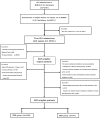Association between early enteral nutrition and 28-Day mortality in mechanically ventilated patients with sepsis: a retrospective analysis of the MIMIC-IV database
- PMID: 40301801
- PMCID: PMC12038982
- DOI: 10.1186/s12879-025-10912-8
Association between early enteral nutrition and 28-Day mortality in mechanically ventilated patients with sepsis: a retrospective analysis of the MIMIC-IV database
Abstract
Background: The optimal timing of enteral nutrition for critically ill septic patients in the intensive care unit (ICU) who require invasive mechanical ventilation has not been determined, and the influence of early enteral nutrition on clinical outcomes is unclear.
Methods: This retrospective observational study utilized data from the Medical Information Mart for Intensive Care IV 2.2 (MIMIC-IV 2.2) database to investigate patients with sepsis who needed invasive mechanical ventilation post-ICU admission. Patients who had enteral nutrition (EN) initiated within 72 h of ICU were categorized into the early enteral nutrition (EEN) group, while those who began enteral nutrition after 72 h were placed in the delayed enteral nutrition (DEN) group. Propensity score matching analysis was performed to compare outcomes between these two groups, with the primary outcome being 28-day mortality.
Results: The final analysis included 2293 patients, 1546 (67.4%) of whom received enteral nutrition within 72 h of invasive mechanical ventilation. The overall 28-day mortality rate was 31.0%. After propensity score matching employing the proximity matching method, Cox survival analysis revealed that early enteral nutrition was associated with increased 28-day mortality in septic patients on invasive mechanical ventilation (hazard ratio(HR) 1.440, 95% CI 1.179-1.760; p < 0.001). The sensitivity and robustness of the evaluation results under different models, including optimal matching (adjusted odds ratio (aOR) 1.52, 95% CI 1.21-1.92, p < 0.001), inverse probability of treatment weighting (aOR 1.27, 95% CI 1.02-1.58, p = 0.034), and logistic regression analysis (aOR 1.48, 95% CI 1.18-1.84, p = 0.001), confirmed the association between early enteral nutrition and increased 28-day mortality in mechanically ventilated septic patients.
Conclusions: Compared to delayed enteral nutrition, early enteral nutrition is associated with higher 28-day mortality in septic patients on invasive mechanical ventilation. Randomized controlled trials are warranted to validate these findings.
Keywords: Enteral nutrition; ICU; Invasive mechanical ventilation; MIMIC-IV; Sepsis.
© 2025. The Author(s).
Conflict of interest statement
Declarations. Ethics approval and consent to participate: The Massachusetts Institute of Technology Institutional Review Board approves the MIMIC IV database. All the database patients are de-identified for privacy protection and the Nanjing Drum Tower Hospital Ethics Committee waives informed consent. The study followed the principles of the Declaration of Helsinki. Consent for publication: Not applicable. Competing interests: The authors declare no competing interests.
Figures




Similar articles
-
Effects of early enteral nutrition on persistent inflammation, immunosuppression, and catabolism syndrome in critically ill patients: A claims database study using a propensity score analysis.Clin Nutr. 2024 Aug;43(8):1872-1879. doi: 10.1016/j.clnu.2024.06.033. Epub 2024 Jun 28. Clin Nutr. 2024. PMID: 38968719
-
Effects of Early Enteral Nutrition on Immune Function and Prognosis of Patients With Sepsis on Mechanical Ventilation.J Intensive Care Med. 2020 Oct;35(10):1053-1061. doi: 10.1177/0885066618809893. Epub 2018 Nov 1. J Intensive Care Med. 2020. PMID: 30384813
-
Impact of early versus delayed enteral nutrition on ICU outcomes: a comparative study on mortality, ventilator dependence, and length of stay.Eur J Med Res. 2025 Apr 22;30(1):315. doi: 10.1186/s40001-025-02579-3. Eur J Med Res. 2025. PMID: 40259420 Free PMC article.
-
Early enteral nutrition (within 48 hours) versus delayed enteral nutrition (after 48 hours) with or without supplemental parenteral nutrition in critically ill adults.Cochrane Database Syst Rev. 2019 Oct 31;2019(10):CD012340. doi: 10.1002/14651858.CD012340.pub2. Cochrane Database Syst Rev. 2019. PMID: 31684690 Free PMC article.
-
Impact of early enteral nutrition in critically ill children: A systematic review and meta-analysis.JPEN J Parenter Enteral Nutr. 2025 May;49(4):428-440. doi: 10.1002/jpen.2738. Epub 2025 Feb 19. JPEN J Parenter Enteral Nutr. 2025. PMID: 39972677
References
Publication types
MeSH terms
LinkOut - more resources
Full Text Sources
Medical
Research Materials

